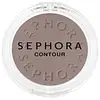Sephora Collection Colorful Contour Matte Powder Versus e.l.f. cosmetics Camo Liquid Bronzer & Contour
What's inside
What's inside
 Key Ingredients
Key Ingredients

 Benefits
Benefits

 Concerns
Concerns

 Ingredients Side-by-side
Ingredients Side-by-side

Mica
Cosmetic ColorantKaolin
AbrasiveCI 77220
Cosmetic ColorantZinc Stearate
Cosmetic ColorantCaprylic/Capric Triglyceride
MaskingOryza Sativa Bran Wax
Skin ConditioningMicrocrystalline Cellulose
AbsorbentCI 77499
Cosmetic ColorantC13-15 Alkane
SolventCI 77007
Cosmetic ColorantCI 77491
Cosmetic ColorantEthylhexylglycerin
Skin ConditioningSorbic Acid
PreservativeCI 77492
Cosmetic ColorantAluminum Hydroxide
EmollientCI 15850
Cosmetic ColorantTocopherol
AntioxidantHelianthus Annuus Seed Oil
EmollientCI 19140
Cosmetic ColorantCI 42090
Cosmetic ColorantCI 77742
Cosmetic ColorantCI 77891
Cosmetic ColorantMica, Kaolin, CI 77220, Zinc Stearate, Caprylic/Capric Triglyceride, Oryza Sativa Bran Wax, Microcrystalline Cellulose, CI 77499, C13-15 Alkane, CI 77007, CI 77491, Ethylhexylglycerin, Sorbic Acid, CI 77492, Aluminum Hydroxide, CI 15850, Tocopherol, Helianthus Annuus Seed Oil, CI 19140, CI 42090, CI 77742, CI 77891
Hydrogenated Polyisobutene
EmollientHydrogenated Poly(C6-14 Olefin)
EmollientOctyldodecanol
EmollientTrimethylolpropane Triisostearate
EmollientBoron Nitride
AbsorbentHydrogenated Styrene/Methylstyrene/Indene Copolymer
C9-12 Alkane
SolventTrimethylsiloxysilicate
EmollientAlumina
AbrasiveIllite
AbrasiveDisteardimonium Hectorite
StabilisingPhenyl Trimethicone
Skin ConditioningEthylene/Propylene/Styrene Copolymer
Propylene Carbonate
SolventSorbitan Sesquioleate
EmulsifyingEthylhexylglycerin
Skin ConditioningTriethoxycaprylylsilane
Tin Oxide
AbrasivePentaerythrityl Tetra-Di-T-Butyl Hydroxyhydrocinnamate
AntioxidantButylene/Ethylene/Styrene Copolymer
Tocopherol
AntioxidantRosa Damascena Flower Water
MaskingWater
Skin ConditioningRicinus Communis Seed Oil
MaskingSodium Hyaluronate
HumectantHydrogenated Castor Oil
EmollientHibiscus Mutabilis Flower Extract
Skin ConditioningPhenoxyethanol
PreservativeCI 77891
Cosmetic ColorantCI 77491
Cosmetic ColorantCI 77492
Cosmetic ColorantCI 77499
Cosmetic ColorantHydrogenated Polyisobutene, Hydrogenated Poly(C6-14 Olefin), Octyldodecanol, Trimethylolpropane Triisostearate, Boron Nitride, Hydrogenated Styrene/Methylstyrene/Indene Copolymer, C9-12 Alkane, Trimethylsiloxysilicate, Alumina, Illite, Disteardimonium Hectorite, Phenyl Trimethicone, Ethylene/Propylene/Styrene Copolymer, Propylene Carbonate, Sorbitan Sesquioleate, Ethylhexylglycerin, Triethoxycaprylylsilane, Tin Oxide, Pentaerythrityl Tetra-Di-T-Butyl Hydroxyhydrocinnamate, Butylene/Ethylene/Styrene Copolymer, Tocopherol, Rosa Damascena Flower Water, Water, Ricinus Communis Seed Oil, Sodium Hyaluronate, Hydrogenated Castor Oil, Hibiscus Mutabilis Flower Extract, Phenoxyethanol, CI 77891, CI 77491, CI 77492, CI 77499
 Reviews
Reviews

Ingredients Explained
These ingredients are found in both products.
Ingredients higher up in an ingredient list are typically present in a larger amount.
Ci 77491 is also hydrated iron III oxide. It's sole purpose is to give a red/pink hue to products.
Iron III oxides are classified as inorganic chemicals for coloring.
Synthetically created Ci 77491 is considered safer than those naturally found. This is because the synthetically created version may contain less impurities. Iron oxides are generally non-toxic and non-allergenic.
Learn more about CI 77491Ci 77492 is also hydrated iron III oxide. It's sole purpose is to give a yellow hue to products.
Iron III oxides are classified as inorganic chemicals for coloring.
Synthetically created Ci 77492 is considered safer than those naturally found. This is because the synthetically created version may contain less impurities. Iron oxides are generally non-toxic and non-allergenic.
Learn more about CI 77492Ci 77499 is also hydrated iron III oxide. It is created from mixing red and black iron oxides. This helps give shades of darkness to a product.
Iron III oxides are classified as inorganic chemicals for coloring.
Ci 77891 is a white pigment from Titanium dioxide. It is naturally found in minerals such as rutile and ilmenite.
It's main function is to add a white color to cosmetics. It can also be mixed with other colors to create different shades.
Ci 77891 is commonly found in sunscreens due to its ability to block UV rays.
Learn more about CI 77891Ethylhexylglycerin (we can't pronounce this either) is commonly used as a preservative and skin softener. It is derived from glyceryl.
You might see Ethylhexylglycerin often paired with other preservatives such as phenoxyethanol. Ethylhexylglycerin has been found to increase the effectiveness of these other preservatives.
Tocopherol (also known as Vitamin E) is a common antioxidant used to help protect the skin from free-radicals and strengthen the skin barrier. It's also fat soluble - this means our skin is great at absorbing it.
Vitamin E also helps keep your natural skin lipids healthy. Your lipid skin barrier naturally consists of lipids, ceramides, and fatty acids. Vitamin E offers extra protection for your skin’s lipid barrier, keeping your skin healthy and nourished.
Another benefit is a bit of UV protection. Vitamin E helps reduce the damage caused by UVB rays. (It should not replace your sunscreen). Combining it with Vitamin C can decrease sunburned cells and hyperpigmentation after UV exposure.
You might have noticed Vitamin E + C often paired together. This is because it is great at stabilizing Vitamin C. Using the two together helps increase the effectiveness of both ingredients.
There are often claims that Vitamin E can reduce/prevent scarring, but these claims haven't been confirmed by scientific research.
Learn more about Tocopherol